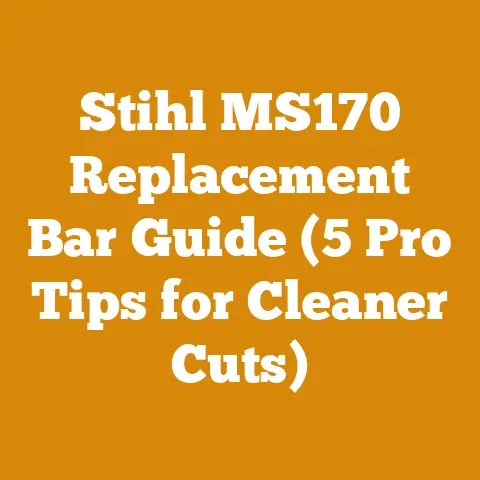How to Get Rid of Ash Borer (Effective DIY Wood Defense)
Remember that old Victorian house I renovated a few years back? The one with the intricate woodwork that seemed to whisper stories of a bygone era? It was a labor of love, but I quickly learned that preserving history often involves battling unseen enemies. In that case, it was the insidious emerald ash borer (EAB), a tiny but devastating insect that could turn a beautiful ash tree into a crumbling mess.
The emerald ash borer wasn’t a problem I was familiar with initially. I’d always been comfortable with chainsaws, wood splitting, and the general art of turning trees into something useful. But invasive pests? That was a new challenge. Now, after a deep dive into entomology, forestry practices, and a whole lot of trial and error, I’ve developed a pretty effective DIY wood defense strategy. I’m going to share what I’ve learned, so you can protect your ash trees and wood resources from this destructive pest. This guide will cover everything from identifying the signs of infestation to implementing preventative measures and, if necessary, dealing with an existing problem.
Understanding the Emerald Ash Borer
Before we jump into the “how-to,” it’s crucial to understand what we’re fighting. The emerald ash borer (Agrilus planipennis) is a metallic green beetle native to Asia. It was first discovered in the United States in 2002, and since then, it’s caused widespread devastation to ash trees across North America and parts of Europe.
The EAB Life Cycle and Damage
The adult EAB beetles lay their eggs on the bark of ash trees. Once the eggs hatch, the larvae bore into the tree’s phloem and cambium layers—the tissues responsible for transporting nutrients and water. As the larvae feed, they create S-shaped galleries that disrupt the tree’s vascular system, eventually killing it.
Here’s a breakdown of the EAB’s life cycle:
- Adult Emergence: Adult beetles emerge from ash trees from late spring to early summer. The timing varies depending on the climate. I’ve noticed in my area (USDA Zone 6) that emergence usually peaks in June.
- Mating and Egg Laying: Adult beetles mate, and the females lay their eggs in bark crevices or under bark flaps of ash trees.
- Larval Development: The eggs hatch, and the larvae bore into the tree’s phloem and cambium layers. They feed and develop throughout the summer and early fall.
- Pupation: The larvae pupate in the tree, typically in the outer sapwood or bark.
- Overwintering: The EAB overwinters as larvae or pupae inside the tree.
Identifying Ash Trees
The first step in defense is knowing your enemy’s target. Ash trees are common in many landscapes, but it’s easy to mistake them for other species. Here are some key characteristics to help you identify ash trees:
- Opposite Branching: Ash trees have opposite branching patterns, meaning that branches grow directly across from each other on the stem.
- Compound Leaves: Ash leaves are compound, consisting of 5-11 leaflets arranged along a central stalk.
- Diamond-Shaped Bark: Mature ash trees have diamond-shaped ridges on their bark.
- Paddle-Shaped Seeds: Ash trees produce clusters of paddle-shaped seeds called samaras.
Recognizing EAB Infestation Signs
Early detection is critical in managing EAB infestations. Keep an eye out for these signs:
- D-Shaped Exit Holes: Adult EAB beetles leave small, D-shaped exit holes (approximately 1/8 inch in diameter) on the bark’s surface. This is a telltale sign.
- Canopy Dieback: The upper crown of the tree may start to thin and die back. This is one of the first visible symptoms.
- Epicormic Shoots: Ash trees under stress often produce new shoots (epicormic shoots) from the trunk or branches.
- Bark Splitting: Vertical splits may appear on the bark, revealing the S-shaped larval galleries underneath.
- Increased Woodpecker Activity: Woodpeckers often feed on EAB larvae, so increased woodpecker activity on ash trees can be a sign of infestation. I’ve personally seen woodpeckers strip the bark completely off infested trees in search of larvae.
DIY Wood Defense Strategies: Prevention is Key
The best defense against EAB is prevention. Here are several strategies you can implement to protect your ash trees and wood resources:
1. Tree Health Management
Healthy trees are more resistant to EAB infestations. Proper tree care practices can improve tree vigor and reduce stress, making them less susceptible to attack.
- Watering: Ensure ash trees receive adequate water, especially during dry periods. Deep watering encourages root growth and overall tree health.
- Specification: Provide 10 gallons of water per inch of trunk diameter every 7-10 days during dry periods.
- Technical Requirement: Use a soaker hose or drip irrigation system to deliver water slowly and deeply to the root zone.
- Mulching: Apply a 2-4 inch layer of organic mulch around the base of ash trees to conserve moisture, suppress weeds, and improve soil health.
- Material Specification: Use wood chips, shredded bark, or compost as mulch. Avoid piling mulch directly against the trunk, as this can create conditions favorable for root rot.
- Fertilizing: Fertilize ash trees in the spring or fall to provide essential nutrients.
- Material Specification: Use a slow-release fertilizer formulated for trees and shrubs. Follow the manufacturer’s instructions for application rates.
- Technical Requirement: Conduct a soil test to determine nutrient deficiencies before applying fertilizer. This ensures that you’re providing the right nutrients in the right amounts.
- Pruning: Prune ash trees to remove dead, damaged, or diseased branches. Proper pruning improves air circulation and reduces the risk of fungal infections.
- Tool Requirement: Use sharp, clean pruning tools to make clean cuts. Disinfect pruning tools between cuts to prevent the spread of disease. I prefer using a solution of 1 part bleach to 9 parts water for disinfecting.
- Technical Requirement: Prune during the dormant season (late winter or early spring) to minimize stress on the tree.
2. Monitoring and Trapping
Regular monitoring can help you detect EAB infestations early, allowing you to take prompt action. Trapping can also help reduce EAB populations in your area.
- Visual Inspections: Conduct regular visual inspections of your ash trees, looking for signs of EAB infestation. Pay close attention to the trunk, branches, and canopy. I recommend inspecting trees at least once a month during the growing season.
- Trap Trees: Trap trees are ash trees that are girdled or otherwise stressed to attract EAB beetles. These trees can then be inspected for EAB larvae, providing an early warning of infestation.
- Technical Requirement: Girdle the trap tree by removing a band of bark and cambium around the entire circumference of the trunk. The band should be approximately 4-6 inches wide.
- Safety Code: Use caution when girdling trees, as they may become unstable and fall.
- Pheromone Traps: Pheromone traps use synthetic pheromones to attract EAB beetles. These traps can be hung in ash trees to monitor EAB populations.
- Material Specification: Use pheromone traps specifically designed for EAB. Follow the manufacturer’s instructions for placement and maintenance. I’ve found that placing traps on the sunny side of the tree, about 6-8 feet off the ground, works best.
- Data Point: Studies have shown that pheromone traps can capture up to 50% of the EAB beetles in a given area.
3. Insecticide Treatments
Insecticide treatments can be used to protect ash trees from EAB infestations. However, it’s essential to use insecticides responsibly and follow all label instructions.
- Systemic Insecticides: Systemic insecticides are absorbed by the tree and distributed throughout its tissues. They can be applied as soil drenches or trunk injections.
- Material Specification: Use systemic insecticides containing active ingredients such as imidacloprid, dinotefuran, or emamectin benzoate.
- Technical Requirement: Apply systemic insecticides in the spring, before EAB beetles emerge. Follow the manufacturer’s instructions for application rates and timing.
- Safety Code: Wear appropriate personal protective equipment (PPE), such as gloves, eye protection, and a respirator, when applying insecticides.
- Limitation: Systemic insecticides may not be effective on heavily infested trees.
- Data Point: Studies have shown that systemic insecticides can provide up to two years of protection against EAB.
- Contact Insecticides: Contact insecticides are applied directly to the bark of ash trees. They kill EAB beetles on contact.
- Material Specification: Use contact insecticides containing active ingredients such as permethrin or bifenthrin.
- Technical Requirement: Apply contact insecticides in the spring or early summer, when EAB beetles are active. Follow the manufacturer’s instructions for application rates and timing.
- Safety Code: Avoid applying contact insecticides during windy conditions or when rain is expected.
- Limitation: Contact insecticides may not provide long-term protection against EAB.
4. Biological Control
Biological control involves using natural enemies to control EAB populations. Several biological control agents are being investigated for EAB management, including parasitic wasps and fungal pathogens.
- Parasitic Wasps: Parasitic wasps lay their eggs inside EAB larvae, eventually killing them. Several species of parasitic wasps are being released in areas affected by EAB.
- Technical Requirement: Purchase parasitic wasps from reputable suppliers. Follow the supplier’s instructions for release rates and timing.
- Data Point: Studies have shown that parasitic wasps can reduce EAB populations by up to 30%.
- Fungal Pathogens: Fungal pathogens can infect and kill EAB larvae. Several fungal pathogens are being developed as biopesticides for EAB management.
- Material Specification: Use biopesticides containing fungal pathogens such as Beauveria bassiana or Metarhizium anisopliae.
- Technical Requirement: Apply biopesticides to the bark of ash trees in the spring or early summer, when EAB beetles are active. Follow the manufacturer’s instructions for application rates and timing.
5. Wood Utilization Strategies
Even if your ash trees become infested with EAB, you can still utilize the wood. However, it’s essential to take precautions to prevent the spread of EAB to other areas.
- Firewood Management: Burn firewood locally to prevent the spread of EAB. Avoid transporting firewood long distances.
- Technical Requirement: Season firewood for at least one year before burning. This will help kill any EAB larvae that may be present in the wood.
- Wood Moisture Content: Firewood should have a moisture content of less than 20% for optimal burning. Use a moisture meter to check the moisture content of your firewood.
- Regulation: Many states and countries have regulations regarding the transportation of firewood to prevent the spread of invasive pests. Check your local regulations before transporting firewood.
- Lumber Production: Ash wood can be used for lumber production. However, it’s essential to kiln-dry the wood to kill any EAB larvae that may be present.
- Technical Requirement: Kiln-dry ash wood to a temperature of 135°F (57°C) for at least one hour to kill EAB larvae.
- Industry Standard: The National Hardwood Lumber Association (NHLA) has established standards for kiln-drying hardwood lumber. Follow these standards to ensure that the wood is properly dried.
- Data Point: Kiln-drying ash wood to the specified temperature and duration will kill 100% of EAB larvae.
- Wood Chipping: Ash wood can be chipped for use as mulch or biomass fuel. The chipping process kills EAB larvae.
- Technical Requirement: Chip ash wood into small pieces (less than 1 inch in diameter) to ensure that EAB larvae are killed.
- Tool Requirement: Use a high-quality wood chipper that can handle the size and type of wood you’re chipping. I’ve found that chippers with a minimum engine size of 15 horsepower are suitable for most ash wood.
Case Study: My Backyard Ash Tree Rescue
I had a beautiful white ash tree in my backyard that I was particularly fond of. It provided shade in the summer and stunning fall color. One day, I noticed some canopy dieback and increased woodpecker activity. Upon closer inspection, I found D-shaped exit holes on the trunk. I knew I had an EAB infestation.
I decided to implement a multi-pronged approach to save my tree:
- Systemic Insecticide Treatment: I applied a soil drench of imidacloprid in the spring, following the manufacturer’s instructions.
- Tree Health Management: I watered the tree regularly during dry periods and applied a layer of mulch around the base.
- Biological Control: I released parasitic wasps in my backyard to help control the EAB population.
Over the next few years, I continued to monitor the tree and reapply the systemic insecticide treatment every other year. The tree showed signs of recovery, with new growth and reduced canopy dieback. While I can’t say for sure that the tree is completely free of EAB, it’s definitely healthier and more vigorous than it was before.
This experience taught me the importance of early detection and proactive management in dealing with EAB infestations. It also reinforced the idea that a combination of strategies is often more effective than relying on a single approach.
Addressing Existing EAB Infestations
If you discover that your ash trees are already infested with EAB, don’t despair. While it may be more challenging to save heavily infested trees, there are still steps you can take to manage the infestation and prevent further spread.
1. Tree Removal
In some cases, tree removal may be the only option, especially if the tree is severely infested or poses a safety hazard.
- Technical Requirement: Hire a qualified arborist to remove infested trees. Ensure that the arborist is familiar with EAB regulations and proper disposal methods.
- Safety Code: Tree removal can be dangerous. Always wear appropriate PPE, such as a hard hat, safety glasses, and gloves.
- Disposal Methods: There are several ways to dispose of EAB-infested trees:
- Burning: Burning infested trees is an effective way to kill EAB larvae. However, check your local regulations before burning.
- Chipping: Chipping infested trees into small pieces will kill EAB larvae.
- Landfilling: Landfilling infested trees can be an option, but check with your local landfill to ensure that they accept EAB-infested wood.
- Data Point: Studies have shown that burning or chipping EAB-infested trees will kill 100% of EAB larvae.
2. Insecticide Treatments (Aggressive Approach)
For trees that are not severely infested, you can try aggressive insecticide treatments to control the EAB population.
- Systemic Insecticides: Apply systemic insecticides as soil drenches or trunk injections. Repeat applications may be necessary.
- Technical Requirement: Follow the manufacturer’s instructions for application rates and timing. Consult with a certified arborist to determine the best insecticide and application method for your situation.
- Contact Insecticides: Apply contact insecticides to the bark of ash trees. Repeat applications may be necessary.
- Technical Requirement: Apply contact insecticides in the spring or early summer, when EAB beetles are active. Avoid applying contact insecticides during windy conditions or when rain is expected.
3. Pruning and Sanitation
Pruning infested branches and removing dead or dying trees can help reduce EAB populations in your area.
- Technical Requirement: Prune infested branches and remove dead or dying trees. Dispose of the pruned branches and trees properly to prevent the spread of EAB.
- Safety Code: Use caution when pruning or removing trees. Wear appropriate PPE, such as a hard hat, safety glasses, and gloves.
Technical Specifications and Requirements Summary
To summarize the key technical specifications and requirements discussed in this guide, here’s a table for easy reference:
| Category | Specification/Requirement | Details |
|---|---|---|
| Tree Health | Watering | 10 gallons of water per inch of trunk diameter every 7-10 days during dry periods. Use soaker hose or drip irrigation. |
| Mulching | 2-4 inch layer of organic mulch (wood chips, shredded bark, compost). Avoid piling against the trunk. | |
| Fertilizing | Slow-release fertilizer for trees and shrubs. Conduct soil test before application. | |
| Pruning | Prune during dormant season (late winter/early spring). Use sharp, clean, disinfected tools. | |
| Monitoring | Visual Inspections | Inspect ash trees at least once a month during the growing season for signs of EAB infestation (D-shaped exit holes, canopy dieback, epicormic shoots, bark splitting, woodpecker activity). |
| Trap Trees | Girdle tree by removing 4-6 inch wide band of bark and cambium around the entire circumference of the trunk. | |
| Pheromone Traps | Use EAB-specific pheromone traps. Place on sunny side of the tree, 6-8 feet off the ground. | |
| Insecticides | Systemic (Soil Drench/Trunk Injection) | Active ingredients: imidacloprid, dinotefuran, emamectin benzoate. Apply in spring before EAB emergence. Follow manufacturer’s instructions. Wear PPE. May not be effective on heavily infested trees. |
| Contact (Bark Spray) | Active ingredients: permethrin, bifenthrin. Apply in spring/early summer when EAB beetles are active. Follow manufacturer’s instructions. Wear PPE. Avoid application during wind or rain. May not provide long-term protection. | |
| Biological Control | Parasitic Wasps | Purchase from reputable suppliers. Follow supplier’s instructions for release rates and timing. |
| Fungal Pathogens | Biopesticides with Beauveria bassiana or Metarhizium anisopliae. Apply to bark in spring/early summer. Follow manufacturer’s instructions. | |
| Wood Utilization | Firewood | Season for at least one year before burning. Moisture content < 20%. Check local regulations for firewood transportation. |
| Lumber | Kiln-dry to 135°F (57°C) for at least one hour to kill EAB larvae. Follow NHLA standards for kiln-drying. | |
| Wood Chipping | Chip into pieces less than 1 inch in diameter to kill EAB larvae. Use a high-quality wood chipper (minimum 15 horsepower). | |
| Tree Removal | General | Hire a qualified arborist familiar with EAB regulations. Wear PPE (hard hat, safety glasses, gloves). Dispose of trees properly (burning, chipping, landfilling). |
Final Thoughts: A Continuous Battle
The fight against the emerald ash borer is an ongoing one. There is no single “magic bullet” solution. It requires a combination of strategies, vigilance, and a willingness to adapt to new information and techniques.
I’ve learned that community involvement is also crucial. Talk to your neighbors, share information, and work together to protect your ash trees. By working together, we can increase our chances of preserving these valuable trees for future generations.
Remember that renovation project I mentioned at the beginning? Well, the ash wood I used for some of the trim came from a tree that had been salvaged from an EAB-infested area. It’s a reminder that even in the face of destruction, there’s always the potential for renewal and creation. And while the battle against the emerald ash borer may be challenging, it’s a battle worth fighting.






